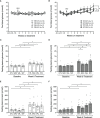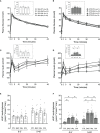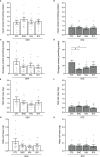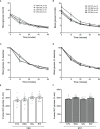Insulinotropic Effects of Neprilysin and/or Angiotensin Receptor Inhibition in Mice
- PMID: 35733766
- PMCID: PMC9207331
- DOI: 10.3389/fendo.2022.888867
Insulinotropic Effects of Neprilysin and/or Angiotensin Receptor Inhibition in Mice
Abstract
Treatment of heart failure with the angiotensin receptor-neprilysin inhibitor sacubitril/valsartan improved glycemic control in individuals with type 2 diabetes. The relative contribution of neprilysin inhibition versus angiotensin II receptor antagonism to this glycemic benefit remains unknown. Thus, we sought to determine the relative effects of the neprilysin inhibitor sacubitril versus the angiotensin II receptor blocker valsartan on beta-cell function and glucose homeostasis in a mouse model of reduced first-phase insulin secretion, and whether any beneficial effects are additive/synergistic when combined in sacubitril/valsartan. High fat-fed C57BL/6J mice treated with low-dose streptozotocin (or vehicle) were followed for eight weeks on high fat diet alone or supplemented with sacubitril, valsartan or sacubitril/valsartan. Body weight and fed glucose levels were assessed weekly. At the end of the treatment period, insulin release in response to intravenous glucose, insulin sensitivity, and beta-cell mass were determined. Sacubitril and valsartan, but not sacubitril/valsartan, lowered fasting and fed glucose levels and increased insulin release in diabetic mice. None of the drugs altered insulin sensitivity or beta-cell mass, but all reduced body weight gain. Effects of the drugs on insulin release were reproduced in angiotensin II-treated islets from lean C57BL/6J mice, suggesting the insulin response to each of the drugs is due to a direct effect on islets and mechanisms therein. In summary, sacubitril and valsartan each exert beneficial insulinotropic, glycemic and weight-reducing effects in obese and/or diabetic mice when administered alone; however, when combined, mechanisms within the islet contribute to their inability to enhance insulin release.
Keywords: angiotensin receptor-neprilysin inhibitor; insulin secretion; mouse; obesity; renin-angiotensin system; sacubitril; type 2 diabetes; valsartan.
Copyright © 2022 Esser, Schmidt, Barrow, Cronic, Hackney, Mongovin, Hogan, Templin, Castillo, Hull and Zraika.
Conflict of interest statement
The authors declare that the research was conducted in the absence of any commercial or financial relationships that could be construed as a potential conflict of interest.
Figures







Similar articles
-
Neprilysin inhibition improves intravenous but not oral glucose-mediated insulin secretion via GLP-1R signaling in mice with β-cell dysfunction.Am J Physiol Endocrinol Metab. 2022 Mar 1;322(3):E307-E318. doi: 10.1152/ajpendo.00234.2021. Epub 2022 Feb 7. Am J Physiol Endocrinol Metab. 2022. PMID: 35128957 Free PMC article.
-
Sacubitril/Valsartan attenuates progression of diabetic cardiomyopathy through immunomodulation properties: an opportunity to prevent progressive disease.Cardiovasc Diabetol. 2025 May 14;24(1):206. doi: 10.1186/s12933-025-02741-5. Cardiovasc Diabetol. 2025. PMID: 40369551 Free PMC article.
-
Sacubitril/Valsartan Combination Partially Improves Cardiac Systolic, but Not Diastolic, Function through β-AR Responsiveness in a Rat Model of Type 2 Diabetes.Int J Mol Sci. 2024 Oct 2;25(19):10617. doi: 10.3390/ijms251910617. Int J Mol Sci. 2024. PMID: 39408945 Free PMC article.
-
Combined Angiotensin Receptor Antagonism and Neprilysin Inhibition.Circulation. 2016 Mar 15;133(11):1115-24. doi: 10.1161/CIRCULATIONAHA.115.018622. Circulation. 2016. PMID: 26976916 Free PMC article. Review.
-
Activation of GLP-1 receptor signalling by sacubitril/valsartan: Implications for patients with poor glycaemic control.Int J Cardiol. 2022 Nov 15;367:81-89. doi: 10.1016/j.ijcard.2022.08.015. Epub 2022 Aug 6. Int J Cardiol. 2022. PMID: 35944765 Review.
Cited by
-
Neprilysin deficiency reduces hepatic gluconeogenesis in high fat-fed mice.Peptides. 2023 Oct;168:171076. doi: 10.1016/j.peptides.2023.171076. Epub 2023 Aug 10. Peptides. 2023. PMID: 37572792 Free PMC article.
-
Gut-specific Neprilysin Deletion Protects Against Fat-induced Insulin Secretory Dysfunction in Male Mice.Endocrinology. 2024 Jul 1;165(8):bqae080. doi: 10.1210/endocr/bqae080. Endocrinology. 2024. PMID: 38953181 Free PMC article.
-
RNA-Seq transcriptomic landscape profiling of spontaneously hypertensive rats in youth treated with a ARNI versus ARB.Naunyn Schmiedebergs Arch Pharmacol. 2025 Jul;398(7):8745-8759. doi: 10.1007/s00210-024-03775-4. Epub 2025 Jan 23. Naunyn Schmiedebergs Arch Pharmacol. 2025. PMID: 39847052
-
LCZ696, an Angiotensin Receptor-Neprilysin Inhibitor, Ameliorates Endothelial Dysfunction in Diabetic C57BL/6 Mice.J Atheroscler Thromb. 2024 Sep 1;31(9):1333-1340. doi: 10.5551/jat.64468. Epub 2024 Apr 13. J Atheroscler Thromb. 2024. PMID: 38616113 Free PMC article.
-
Acute Inhibition of Intestinal Neprilysin Enhances Insulin Secretion via GLP-1 Receptor Signaling in Male Mice.Endocrinology. 2023 Mar 13;164(5):bqad055. doi: 10.1210/endocr/bqad055. Endocrinology. 2023. PMID: 36964914 Free PMC article.
References
-
- Seferovic JP, Claggett B, Seidelmann SB, Seely EW, Packer M, Zile MR, et al. . Effect of Sacubitril/Valsartan Versus Enalapril on Glycaemic Control in Patients With Heart Failure and Diabetes: A Post-Hoc Analysis From the PARADIGM-HF Trial. Lancet Diabetes Endocrinol (2017) 5(5):333–40. doi: 10.1016/S2213-8587(17)30087-6 - DOI - PMC - PubMed
-
- Nougue H, Pezel T, Picard F, Sadoune M, Arrigo M, Beauvais F, et al. . Effects of Sacubitril/Valsartan on Neprilysin Targets and the Metabolism of Natriuretic Peptides in Chronic Heart Failure: A Mechanistic Clinical Study. Eur J Heart Fail (2019) 21(5):598–605. doi: 10.1002/ejhf.1342 - DOI - PubMed
Publication types
MeSH terms
Substances
Grants and funding
LinkOut - more resources
Full Text Sources
Medical

